Garden hoses are essential for maintaining lush lawns, tending to plants, and carrying out various outdoor tasks.
However, many homeowners may not be aware of the potential risks associated with the backflow of water through their garden hoses.
Backflow occurs when water flows in the opposite direction than intended, potentially allowing contaminants to enter the water supply. To mitigate this risk, the installation of a backflow preventer becomes crucial.
In this blog post, we will explore the importance of backflow prevention and answer the question: Do you need a backflow preventer on your garden hose?
Yes. It is especially important for those who are using hose-end fertilizer or pesticide applicators, mixing pesticides, or leaving a pressurized hose attached to a sprinkler or another device.
Do I Need a Backflow Preventer on My Garden Hose?

Definitely, the backflow preventer (backflow valve) prevents water from flowing from a garden hose into the water supply.
Using a garden hose faucet line without a backflow preventer protects the water supply from contaminants or chemicals.
Backflow preventers should be installed on outdoor faucets by gardeners who are aware of this responsibility.
Garden hose check valves are made from brass and are only marginally larger than outdoor garden hoses.
The male and female sides both have attachment terminals. Only a few inches and a few ounces of weight and length are measured throughout this unit. We will go into great detail about it in the next section.
How Does a Backflow Preventer Work

The water from those building systems, such as plumbing leaks or wastewater management, can backflow further into the central municipal supply system. The water pipelines are subject to pressure fluctuations due to this.
In such situations, contaminants like hazardous chemicals, human waste, etc., can be extremely dangerous. Generally speaking, it may contaminate water supplies.
Using a backflow preventer could provide homeowners like you with several benefits. Installing a backflow preventer is one of the best foolproof methods for maintaining good health.
Furthermore, household drinking water will remain contaminant-free. Installing a backflow preventer can protect the plumbing system from impurities, extending the pipe’s life.
As a result of installing a backflow preventer, homeowners won’t have to worry about contaminated drinking water or expensive repairs.
Understanding One Way & Backflow
To begin with, we need to understand that water should flow only in one direction. Good water comes from the faucets (clean water from the supply source).
Directing dirty or bad water away from the clean source is essential as it flows from drains and toilets.
In terms of backflow, the concept is simple. A diaphragm is spring-loaded and is subject to pressure as water flows.
Whenever there is pressure on the flow side, nothing can push back on the spring-loaded diaphragm. Consequently, there is only one way to flow.
How Does Contamination Occur
The water pressure drops when a municipal pump fails, or a fire hydrant uses a large amount of water.
This can cause the garden hose (or other water faucet) to siphon water, contaminants, and chemicals back into the water supply, creating a siphon effect. The spray nozzles and chemical injectors can also cause backflow.
Normally, when the faucet runs, the nozzle stops the flow of water, but if an excessive amount of water is used inside, such as when the washing machine or toilet flushes, the water from the hose is pulled back into the municipal supply.
Homeowners in the Phoenix area should also be aware of the heat. The air expands in response to the heat, creating pressure in the atmosphere.
During the summer, the heat can force any water trapped in hoses back into municipal supplies if the air is trapped there.
Backflow Prevention Types

In addition to the variety of designs available, each backflow preventer has its own unique uses and functions. Plumbers can help you choose the right type for your home and what the municipality requires.
Our goal here is to show you how backflow preventers operate and the different types of backflow preventers.
Hose Bib Vacuum Breaker
There is often a hose bib vacuum breaker used on outdoor faucets with hose connections. This threaded device, which is fastened to the spigot with a spring-loaded check valve, prevents backflow.
If the water is allowed to flow only one way, then non-potable water cannot be siphoned through the hose’s end. Furthermore, the valve would open and close according to the water pressure.
Reduced Pressure Zone Device
In terms of complexity and cost, a reduced pressure zone device is the most complex and expensive backflow preventer.
Reduced pressure zones are sometimes called reduced pressure principle assemblies. If this type of backflow prevention device functions correctly, it is the most secure and reliable among all the available options.
An intake shutoff valve, four test cocks, two spring-loaded check valves, a pressure differential relief valve, and an outlet shutoff valve comprise a reduced pressure zone.
Double Check Valve Assembly (DCA)
Two independently operating, authorized check and shutdown valves are installed at each end of the assembly, linked by properly located robust test cocks.
Air Gap
The third type of backflow preventer is a barrier that separates the free-flowing discharge end of a drinking water pipe from an open vessel or low-pressure receiving area.
There should be no risk involved when using this technique. When calculated vertically above the overflow lip of the receiving vessel, an “allowed air gap” should measure twice the width of the supply pipe.
Pressure Vacuum Breaker Assembly (PVB)
The check valve on the check valve’s side is operated separately and independently, and it is actuated by an internal actuator on its discharge-side filled inlet valve.
During assembly, the assembly must be highly protected with seated testing cocks and shutoff valves that close tightly and are tightly connected.
Air Vacuum Breaker Assembly (AVB)
Known as an AVB, the non-pressure type vacuum breaker has an air inlet valve, a port, and a check seat. If water enters the body, the air inlet valve closes off the air inlet port.
If the water flow is stopped, the air intake valve collapses and acts as a check valve to prevent reverse siphonage. In this way, the air input port opens, allowing air to enter and fill the vacuum.
It must be noted that shutoff valves or impediments must not be present downstream. A shutoff valve can be located directly upstream of the assembly. No more than 12 hours can be spent under operating strain on any assembly in 24 hours.
Backflow Preventer And Check Valves—Are They The Same
Despite sharing similar operating principles, check valves and backflow preventers fulfil very different purposes. Where check valves and backflow preventers are used is their primary difference.
Backflow preventers use fail-safe elements such as a check valve in low-risk settings to limit reverse water flow but have no similar fail-safe features as a check valve.
Backflow preventers are installed in high-risk environments and, as such, are entirely designed to protect potable water. Let’s begin by examining the primary causes of backflow.
It may be the result of both back pressure and back siphoning. As a consequence of the source piping being under more significant pressure than the downstream piping, backpressure occurs.
It could be caused by pumping, a temperature contraction, or high head pressure, among other factors.
Back siphoning occurs when there is negative pressure inside the supply piping. Water may revert back to the source line upon a water main break or increased draw rates produced by the outflow of a fire hydrant, for example.
As downstream chemically treated water, such as that found in HVAC cooling water loops or a garden sprayer, can contaminate public water supplies at either end, the proper safeguards must be in place.
During backflow, contaminants, including chemicals, bacteria, and sediment, are sucked into the capital’s water system pipe for domestic use before they are delivered to consumers for subsequent use.
Do I Need To Install A Backflow Preventer?
Backflow prevention is not needed in most residential properties. If you have an irrigation system at your house, you may be required to install it by your town hall.
There are many local governments across the country that mandate backflow testing for business plumbing systems on an annual basis.
It is mandatory to test household preventer devices on an yearly basis in regions where they are instructed.
It is recommended that the test be performed by a licensed plumber who has worked with preventer devices before. Plumbing professionals ensure that every preventer is operational before putting it into service.
Several plumbing companies provide this service as part of their licensing and compliance procedures.
During testing, a plumber may fix a malfunctioning device. Sometimes, if repairs do not work, a replacement is necessary.
The Bottom Line
Regular home maintenance and repairs involve maintaining the quality and safety of water in a home. In the United States, 71% of households drink tap water, so keeping impurities and contaminants out of the supply is essential.
Water from the garden hose can enter the water supply through a backflow preventer. If a backflow preventer is not connected to the garden hose spigot or faucet line, contaminants will infiltrate the water supply.








